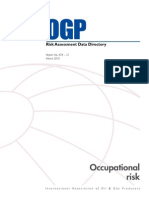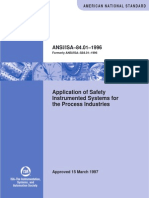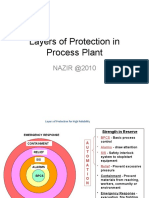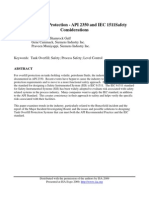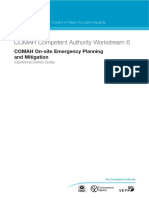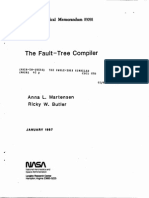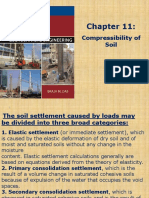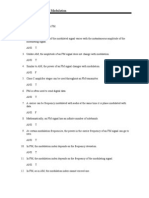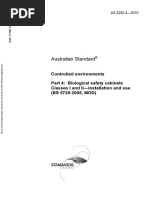How To Generate F-N Curves: Risk Analysis For Information and Systems Engineering
How To Generate F-N Curves: Risk Analysis For Information and Systems Engineering
Uploaded by
ALIKNFCopyright:
Available Formats
How To Generate F-N Curves: Risk Analysis For Information and Systems Engineering
How To Generate F-N Curves: Risk Analysis For Information and Systems Engineering
Uploaded by
ALIKNFOriginal Description:
Original Title
Copyright
Available Formats
Share this document
Did you find this document useful?
Is this content inappropriate?
Copyright:
Available Formats
How To Generate F-N Curves: Risk Analysis For Information and Systems Engineering
How To Generate F-N Curves: Risk Analysis For Information and Systems Engineering
Uploaded by
ALIKNFCopyright:
Available Formats
1
How to generate F-N curves
INSE 6320 -- Week 5
Risk Analysis for Information and Systems Engineering
F-N Curves
Fault Trees
Event Trees
Dr. A. Ben Hamza
The frequency of events which causes at least N fatalities is plotted
against the number N on log log scales
The difference between the frequency of events with N or more
fatalities, F(N), and that with N+1 or more, F(N+1), is the frequency of
events with exactly N fatalities, usually represented by f(N), with lowercase f. This means f(N) = F(N)-F(N+1)
Because f(N) must be non-negative, it follows that F(N) F(N+1) for all
N, so that FN-curves never rise from left to right, but are always falling
or flat
The lower an FN curve is located on the F-N graph, the safer is the
system it represents, because lower FN curves represent lower
frequencies of fatal events than higher curves.
Concordia University
2
F-N curves
Societal risk
Usually used to express societal risk.
Important to define acceptable / tolerable risk
The value F(1) is the frequency of accidents with 1 or more
fatalities, or in other words the overall frequency of fatal accidents.
This is the left-hand point on FN-curves, where the curve meets
the vertical axis (usually located at N = 1 with logarithmic scales).
FN curves can be constructed based on historical data in the form
of number of events (floods, landslides, etc) and related fatalities
They can also be based on different future risk scenarios, in which
for a number of events with different magnitudes the number of
casualties is estimated
Risk acceptability is mostly defined on the basis of F-N curves
F-N curves show the number of Fatalities against annual frequency.
How to calculate F-N curves
How to calculate F-N curves
Plot these values in the graph indicated at the bottom of the spreadsheet in a log-log manner,
In this exercise you will calculate F-N curves for accidents that have occurred in
Europe in the period 1967 to 2001 (i.e., 35 years).
Three different types of accident data area available: for roads, railroad and aviation.
The analysis is based on empirical data, collected from historical accidents records.
with Fatalities (N) or the X-axis, and the cumulative frequency per year on the Y-Axis.
Compare the results. What can you conclude on the :
Severity of the accident type
Frequency of the accident type
How to calculate F-N curves
First calculate the total number of fatalities for road, railroad and aviation accidents by multiplying
the number of events with the fatality class. Also calculate the average number of fatalities per
year..
Then calculate the cumulative number of events, starting with the lowest one in the table (related
to 146 fatalities) and summing them up upwards.
Then calculate the cumulative frequency of events per year, by dividing the cumulative number by
the number of years.
Probabilistic Risk Assessment
Probabilistic Risk Assessment usually answers three basic questions:
1) What can go wrong with the studied technological entity, or what are the initiators
or initiating events (undesirable starting events) that lead to adverse
consequence(s)?
2) What and how severe are the potential adverse consequences that the
technological entity may be eventually subjected to as a result of the occurrence
of the initiator?
3) How likely to occur are these undesirable consequences, or what are their
probabilities or frequencies?
Two common methods of answering this last question are Fault Tree Analysis
and Event Tree Analysis.
A fault tree is an event tree, where failures are emphasized rather than
successes
Fault Tree Analysis
Fault Tree Analysis (FTA) is one of the most important logic and probabilistic
techniques used in Probabilistic Risk Assessment (PRA) and system reliability
assessment.
Fault Tree Analysis is a deductive method for identifying ways in which hazards
can lead to accident.
The approach starts with a well defined accident, or top event, and works
backwards towards the various scenarios that can cause the accident.
Fault trees are used to determine the probability of a top event (e.g., core
damage).
Top event defines the failure or success of a system or component
Fault trees use a structure of logical operations to calculate the probability of the
top event as a result of basic events inputs
11
Fault Tree Analysis
The undesired event is stated at the top of the tree
The fault tree gates specify logical combinations of
basic events that lead to the top event
Fault trees can be used to identify system weaknesses
Fault trees can help recognize interrelationships
between fault events
Fault trees consist of logic gates and basic events as
AND Gate:
inputs to the logic gates
Logic Gates: Boolean operations (union or
intersection) of the input events
Basic Events: Faults such as a hardware failure,
human error, or adverse condition
10
Fault Tree Analysis
Fault tree analysis is a graphical representation of the combination of faults
that will result in the occurrence of some (undesired) top event.
In the construction of a fault tree, successive subordinate failure events are
identified and logically linked to the top event.
The linked events form a tree structure connected by symbols called gates.
12
Applying Fault Tree Analysis
Postulate top event (fault)
Branch down listing faults in the system that must occur for the
top event to occur
Consider sequential and parallel or combinations of faults
Use Boolean algebra to quantify fault tree with event probabilities
Determine probability of top event
Fault Tree Logic
Use logic gates to show how top event occurs
Higher gates are the outputs from lower gates in the tree
Top event is output of all the input faults or events that occur
13
FTA Symbols
Basic Event:
15
Intersection
A lower most event that can not be further developed.
E.g. Relay failure, Switch failure etc.,
Over-heated
Wire
D=E.F
D= E Intersection F
E AND F must occur
for D to occur
An Event / Fault: This can be a intermediate event (or) a top event. They
are a result logical combination of lower level events.
E.g. Both transmitters fail, Run away reaction
OR Gate:
Either one of the bottom event results in occurrence of
the top event.
E.g. Either one of the root valve is closed, process signal
to transmitter fails.
AND Gate:
For the top event to occur all the bottom events should
occur.
E.g. Fuel, Oxygen and Ignition source has to be present
for fire.
E
5mA Current
in System
F
Power Applied
t >1ms
14
Union
16
Fault Tree Basics
Top level event
No Current
A=B+C
A=B Union C
B OR C must occur
for event A to occur
Switch A
Open
Battery B
0 Volts
A fault tree involves:
Specifying a top level event (TLE)
representing an undesired state.
Find all possible chains of basic events
that may cause the TLE to occur.
A fault tree:
Is a systematic representation of such
chains of events.
Uses logical gates to represent the
interrelationships between events and
TLE, e.g. AND, OR.
Intermediate
events
Basic events
An example fault tree
Logically: (A + (B + C)) . (C + (A . B))
17
19
Minimal Cut Set Theory
Fault Tree Basics
Logically, fault trees are equivalent if the associated logical
The fault tree consists of many levels of basic and intermediate events linked
together by AND and OR gates. Some basic events may appear in different
places of the fault tree.
The minimal cut set analysis provides a new fault tree, logically equivalent to
the original, with an OR gate beneath the top event, whose inputs (bottom) are
minimal cut sets.
Cut Set: is a set of basic events whose simultaneous occurrence ensures that
the TOP event occurs.
Minimal Cut Set: is a cut set that does not contain another cut set as a
subset.
Each minimal cut set is an AND gate with a set of basic event inputs
necessary and sufficient to cause the top event.
The fault tree can be represented by the TOP structure and the minimal cut
sets connected through a single OR-gate.
formulae are equivalent.
Example:
(A + (B + C)) . (C + (A . B))
C + (A . B)
18
20
Minimal Cut Sets
Procedure
Procedure for Fault Tree Analysis
Define TOP
event
Define overall
structure.
This shape is of particular interest
representation in terms of Minimal Cut Sets
(MCS).
Explore each
branch in
successive level
of detail.
Minimal cut set = smallest set of basic events
which, in conjunction, cause the top level event
to occur.
Perform
corrections if
required and
make decisions
Solve the fault
tree
Solve the Fault Tree:
Assign probabilities of failure to the lowest level event in each branch of the tree.
From this data the intermediate event frequency and the top level event frequency
can be determined using Boolean Algebra and Minimal Cut Set methods.
Logically: Disjunctive Normal Form (DNF) =
MCSs
disjunction of conjunctions of basic events.
The fault tree on the left has two minimal cut
sets: C (single point of failure) and A.B (cut
set of order 2).
21
Fault Tree Construction
Procedure
Consider the following block diagram. Let I/P and O/P be the input and output terminals.
There are two sub-systems A and B that are connected in series.
Steps to get the final Boolean equation:
1. Replace
23
TOP
AND gates with the product of their inputs.
IE1 = A.B
X1
IE2 = C.D
X3
INPUT
2. Replace OR gates with the sum of their inputs.
IE1
IE2
OUTPUT
X2
TOP = IE1+IE2
SUB - SYSTEM (A)
= A.B+C.D
3. Continue this replacement until all intermediate event gates
X4
SUB - SYSTEM (B)
have been replaced and only the basic events remain in the
For this the fault tree analysis diagram shown in next slide
equation.
TOP = A.B+C.D
22
Procedure
Boolean Algebra Reduction Example:
TOP
= IE1 + IE2
= (A.B) + (A + IE3)
= A.B + A + (C.D.IE4)
= A.B + A + (C.D.D.B)
= A + A.B + B.C.D.D
(D.D = D)
= A + A.B + B.C.D
(A + A.B = A)
= A + B.C.D
So the minimal cut sets are:
CS1 = A
CS2 = B.C.D
meaning TOP event occurs if
either A occurs OR (B.C.D) occurs.
24
Continue..
F (S)
Top event
OR
TOP
IE1
IE2
F (A)
F (B)
AND
AND
intermediate event
IE3
IE4
F( X1)
F( X2)
F( X 3)
F( X 4)
Basic event
25
27
Uses of FTA
Continue..
Use of FTA to understand of the logic leading to the top event.
Here F(X1) , F(X2) , F(X3), F(A4) Are Events Fail
Use of FTA to prioritize the contributors leading to the top event.
F (A) = SUB SYSTEM (A) FAILS
Use of FTA as a proactive tool to prevent the top event.
Use of FTA to monitor the performance of the system.
Use of FTA to minimize and optimize resources.
THEN F(A) = F(X1) AND F(X2)
Use of FTA to assist in designing a system.
AND F(B) = F(X3) AND F(X4)
Use of FTA as a diagnostic tool to identify and correct causes of the top event.
F(B) = SUB SYSTEM (B) FAILS
FINALLY THE FAILURE OF THE SYSTEM
F(S) = F(A) OR F(B)
Advantages
Disadvantages
Begins with top event.
Complicated process.
Use to determine the minimal cut sets.
Require considerable amount of time to complete.
26
Calculation of Reliability from Fault Tree
CONSIDER THE EARLIER BLOCK DIAGRAM
The probability of failure of sub system (A) is indicated as shown in below,
P(A) = P (X 1 and X 2)
P(A) = P( X1) . P( X 2)
Similarly for sub system (B)
28
Event Trees
Event trees begin with an initiating event & work towards the final result.
This method provides information on how a failure can occur & the
probability of occurrence.
Event trees can be viewed as a special case of fault trees, where the
branches are all ORs weighted by their probabilities.
Event trees are generated both in the success and failure domains.
This technique explores system responses to an initiating challenge and
enables assessment of the probability of an unfavorable or favorable
outcome. The system challenge may be a failure or fault, an undesirable
event, or a normal system operating command.
In constructing the event tree, one traces each path to eventual success or
failure.
P(B) = P( X 3 and X 4)
P(B) = P( X 3) . P( X 4)
FAILURE OCCURS WHEN SUB SYSTEM (A) or (B) FAIL..,
F (S) = P(A) or P(B) THEN
F(S) = P(A) + P(B) ( P(A) . P(B) )
IF THE RELIABILITY OF THE ELEMENTS ARE GIVEN BY R1,R2,R3,R4
THEN
P( Xi ) = 1 Ri
RELIABILITY OF SYSTEM R(S) = 1 - F(S)
29
31
30
32
Event tree development procedure
Step 1: Identification of the initiating event
Step 2: Identification of safety function
Step 3: Construction of the event tree
Step 4: Classification of outcomes
Step 5: Estimation of the conditional probability of each branch
Step 6: Quantification of outcomes
Step 7: Evaluation
Event Tree Structure
Event Tree Analysis
ADVANTAGES
Structured, rigorous, and methodical approach.
Can be effectively performed on varying levels of design detail.
Permits probability assessment.
DISADVANTAGES
An ETA can only have one initiating event, therefore multiple ETAs will be
required to evaluate the consequence of multiple initiating events.
Partial successes/failures are not distinguishable.
Requires an analyst with some training and practical experience.
You might also like
- GP 43.0 PUWER-Equipment-Safety-ChecklistDocument4 pagesGP 43.0 PUWER-Equipment-Safety-ChecklistLarbi BelazizNo ratings yet
- Flow DiagramDocument6 pagesFlow DiagramMuhammad ArshadNo ratings yet
- Quantitative Risk AssessmentDocument1 pageQuantitative Risk AssessmentDubey DeepakNo ratings yet
- Methods of Approximation and Determination of Human Vulnerability For Offshore Major Accident Hazard AssessmentDocument55 pagesMethods of Approximation and Determination of Human Vulnerability For Offshore Major Accident Hazard AssessmenthazopmanNo ratings yet
- Bhopal QRA V3Document29 pagesBhopal QRA V3just_checking100% (1)
- GPG35 Pipeline Process Safety Studies and Methodologies Ed 1Document38 pagesGPG35 Pipeline Process Safety Studies and Methodologies Ed 1snikraftar1406No ratings yet
- OGP - Occupational Risk - March 2010Document14 pagesOGP - Occupational Risk - March 2010btjajadiNo ratings yet
- 52 (Consequence Analysis)Document18 pages52 (Consequence Analysis)Aditya Pranoto100% (1)
- Dropped Object Reference ReportDocument18 pagesDropped Object Reference Reportsnikraftar1406No ratings yet
- QRA DraftDocument38 pagesQRA DraftKishore Reddy100% (1)
- S 8401 PDFDocument110 pagesS 8401 PDFNur Khunainah WahyuniNo ratings yet
- Ehs Weekly Data Report: Company: Pt. Viking - Day Shift Period 8-14NOV 2019Document1 pageEhs Weekly Data Report: Company: Pt. Viking - Day Shift Period 8-14NOV 2019Sanjay Kumar GhadaiNo ratings yet
- LOPA ChecklistDocument2 pagesLOPA ChecklistSumitAggarwalNo ratings yet
- Appendix - G3 - Pre Feasibility Design HAZID Study and QRA Report Rev B BVi SignedDocument20 pagesAppendix - G3 - Pre Feasibility Design HAZID Study and QRA Report Rev B BVi SignedWeddie MakomichiNo ratings yet
- The QRAQ Project Volume 4 Frequency of R PDFDocument66 pagesThe QRAQ Project Volume 4 Frequency of R PDFNelson Alvarez50% (2)
- Kenexis: Understanding Fire and Gas Mapping Software and EffigyDocument34 pagesKenexis: Understanding Fire and Gas Mapping Software and EffigyShakeel AhmedNo ratings yet
- Appendix For SIL AssessmentDocument21 pagesAppendix For SIL AssessmentPanchdev KumarNo ratings yet
- N05A 7 10 0 70030 01 05 Risk Assessment Dropped Object Analysis - SignedDocument45 pagesN05A 7 10 0 70030 01 05 Risk Assessment Dropped Object Analysis - SignedMustafa ShabanNo ratings yet
- Layers of Protection in Process Plant: NAZIR @2010Document41 pagesLayers of Protection in Process Plant: NAZIR @2010Muhammad NazirNo ratings yet
- 8 Vedlegg BDocument13 pages8 Vedlegg BGilang RomadhonNo ratings yet
- Ep 95 0300 - (Hemp)Document85 pagesEp 95 0300 - (Hemp)alokcNo ratings yet
- Guidelines For Quantitative Risk Assessment (Qra) StudyDocument12 pagesGuidelines For Quantitative Risk Assessment (Qra) StudyYanka IlarionovaNo ratings yet
- Tank Overfill Protection - API 2350 and IEC 1511safety ConsiderationsDocument10 pagesTank Overfill Protection - API 2350 and IEC 1511safety ConsiderationsAyanleh Idriss HassanNo ratings yet
- Diference Between HAZID and HAZOPDocument2 pagesDiference Between HAZID and HAZOPQueziaNo ratings yet
- QuanRiskAssessment and Consequence Modelling-Student MaterialDocument108 pagesQuanRiskAssessment and Consequence Modelling-Student MaterialBedalo BesanlaNo ratings yet
- HAZID ModifiedDocument14 pagesHAZID Modifiedchem_taNo ratings yet
- FGS Handbook Rev DDocument19 pagesFGS Handbook Rev DkokykarkarNo ratings yet
- Layer of Protection Analysis (LOPA) : Timothy StirrupDocument14 pagesLayer of Protection Analysis (LOPA) : Timothy StirrupjoesuhreNo ratings yet
- Air Modelling ReportDocument8 pagesAir Modelling ReportadiNo ratings yet
- Safety Management System in Hydrocarbon IndustryDocument98 pagesSafety Management System in Hydrocarbon IndustryAnkur Pathak89% (9)
- Process Control WWTP3Document44 pagesProcess Control WWTP3Arima KouseiNo ratings yet
- On Site Emergency Planning ComahDocument16 pagesOn Site Emergency Planning Comahأحمد القماطيNo ratings yet
- Process Safety Lessons LearnedDocument39 pagesProcess Safety Lessons LearnedChimaovu Ehoro100% (2)
- DnvenergyDocument74 pagesDnvenergySoroushMalekiNo ratings yet
- Human Factors (HOF) in ATEXDocument6 pagesHuman Factors (HOF) in ATEXMarcus HartfelderNo ratings yet
- Case Study Human Factors - Alarm Failure - Risk ReductionDocument8 pagesCase Study Human Factors - Alarm Failure - Risk ReductionMuhammad TaufikNo ratings yet
- Summary Report On Helicopter Ditching and Crashworthiness ResearchDocument193 pagesSummary Report On Helicopter Ditching and Crashworthiness ResearchmegustalazorraNo ratings yet
- 544 201604 Standardization of Barrier DefinitionsDocument25 pages544 201604 Standardization of Barrier DefinitionsMohaan MuraliNo ratings yet
- Assumption Sheet 01Document12 pagesAssumption Sheet 01Nambi PurushothNo ratings yet
- Opi SG Hse 010 E&p r01 - Hazard & Operability (HAZOP) MethodologyDocument53 pagesOpi SG Hse 010 E&p r01 - Hazard & Operability (HAZOP) MethodologyRamzi SaadaouiNo ratings yet
- HAZOP TG Sekong DraftDocument51 pagesHAZOP TG Sekong DraftAnonymous akyLdkCB4FNo ratings yet
- Rupture DiscDocument4 pagesRupture DiscsaichandrakanthanNo ratings yet
- 6 - Appendix D2 - Risk Assessment PDFDocument95 pages6 - Appendix D2 - Risk Assessment PDFEmiliano VendittiNo ratings yet
- Executive Summary - IOC Fire ReportDocument9 pagesExecutive Summary - IOC Fire ReportDeep Chaudhari0% (1)
- ALARPDocument7 pagesALARPArgenis José Medina SotilloNo ratings yet
- Instructions: Industrial EcologyDocument5 pagesInstructions: Industrial EcologyAdamNo ratings yet
- Ignition Model Ukooa Hse Ip JipDocument16 pagesIgnition Model Ukooa Hse Ip Jipsasankar_yh50% (2)
- Process Hazard AnalysisDocument10 pagesProcess Hazard AnalysisMohamed AchourNo ratings yet
- 5.6 Dow FEI V1.4Document37 pages5.6 Dow FEI V1.4gangaraNo ratings yet
- EnvironmentalDocument368 pagesEnvironmentalPaulina MorenoNo ratings yet
- Consequence ModellingDocument13 pagesConsequence ModellingMuhammad.SaimNo ratings yet
- SafetyCaseGuidelines PDFDocument190 pagesSafetyCaseGuidelines PDFgad480No ratings yet
- Hazard Identification, Risk Assessment and Control Record Register For Offshore ActivitiesDocument4 pagesHazard Identification, Risk Assessment and Control Record Register For Offshore Activitiespvs12684100% (2)
- Emergency Relief System Design Using DIERS Technology: The Design Institute for Emergency Relief Systems (DIERS) Project ManualFrom EverandEmergency Relief System Design Using DIERS Technology: The Design Institute for Emergency Relief Systems (DIERS) Project ManualRating: 4 out of 5 stars4/5 (1)
- Lecture 5Document60 pagesLecture 5ssrkr96No ratings yet
- The Fault-Tree Compiler: Nasa Technical Memorandum 89098Document40 pagesThe Fault-Tree Compiler: Nasa Technical Memorandum 89098Anonymous XS9jAhY1pENo ratings yet
- Fault Tree AnalysisDocument24 pagesFault Tree AnalysisAntaryami01No ratings yet
- FTA-Failure Treee AnalysysDocument30 pagesFTA-Failure Treee AnalysyscalfredcNo ratings yet
- Fault TreeDocument45 pagesFault Treerusticrage2883100% (2)
- S2024 L26-27 Event TreeDocument29 pagesS2024 L26-27 Event TreeTimothy StudebakerNo ratings yet
- Civ324 HW3Document1 pageCiv324 HW3ALIKNFNo ratings yet
- CH 11 Compressiblity NewDocument72 pagesCH 11 Compressiblity NewALIKNFNo ratings yet
- Civ324 HW1Document1 pageCiv324 HW1ALIKNFNo ratings yet
- Ch-10-Stresses in A Soil MassDocument62 pagesCh-10-Stresses in A Soil MassALIKNFNo ratings yet
- CIV324 - Geotechnical EngineeringDocument5 pagesCIV324 - Geotechnical EngineeringALIKNFNo ratings yet
- CH 8 SeepageDocument30 pagesCH 8 SeepageALIKNFNo ratings yet
- CH 4 ClassificationDocument25 pagesCH 4 ClassificationALIKNFNo ratings yet
- Assignment 8 6331 PDFDocument11 pagesAssignment 8 6331 PDFALIKNFNo ratings yet
- CH 2 MineralogyDocument36 pagesCH 2 MineralogyALIKNFNo ratings yet
- CH 9 Insitu StressesDocument33 pagesCH 9 Insitu StressesALIKNFNo ratings yet
- Fig. 1 The Process Yield HistogramDocument10 pagesFig. 1 The Process Yield HistogramALIKNFNo ratings yet
- Assignment 4 6331 PDFDocument10 pagesAssignment 4 6331 PDFALIKNFNo ratings yet
- Acceptance Sampling by Variables: LSL X Z K ZDocument16 pagesAcceptance Sampling by Variables: LSL X Z K ZALIKNFNo ratings yet
- In6331outl 2017W PDFDocument2 pagesIn6331outl 2017W PDFALIKNFNo ratings yet
- Assignment 7 6331 PDFDocument11 pagesAssignment 7 6331 PDFALIKNFNo ratings yet
- Assignment 6 6331 PDFDocument5 pagesAssignment 6 6331 PDFALIKNFNo ratings yet
- Assignment 1 6331Document4 pagesAssignment 1 6331ALIKNFNo ratings yet
- Lec 4Document13 pagesLec 4ALIKNFNo ratings yet
- Lec 6Document27 pagesLec 6ALIKNFNo ratings yet
- 18-10-12 Apple & Contr Manuf Ex Parte '878 Patent ExhaustionDocument220 pages18-10-12 Apple & Contr Manuf Ex Parte '878 Patent ExhaustionFlorian MuellerNo ratings yet
- Manual Instruction CPAM-EKA AIR C16 EKA KOOL V2Document8 pagesManual Instruction CPAM-EKA AIR C16 EKA KOOL V2Tam DuongNo ratings yet
- OCTFDocument30 pagesOCTFVidhya100% (1)
- 193 - 08-7 - PR 42-45 - Work Done On A System by An External ForceDocument3 pages193 - 08-7 - PR 42-45 - Work Done On A System by An External ForceBradley Nartowt, PhD100% (1)
- 46 CFR Part 153Document130 pages46 CFR Part 153hsaioudNo ratings yet
- 2N Access Unit Installation Manual EN 2.11 PDFDocument98 pages2N Access Unit Installation Manual EN 2.11 PDFlevishoangNo ratings yet
- Img 20240519 Wa0011Document1 pageImg 20240519 Wa0011smart.net0104No ratings yet
- Fourier Series: Periodic PhenomenaDocument3 pagesFourier Series: Periodic PhenomenasatyamNo ratings yet
- Javascript - Jqplot Tooltip On Bar Chart - Stack OverflowDocument2 pagesJavascript - Jqplot Tooltip On Bar Chart - Stack OverflowJaviAgredoNo ratings yet
- Data Sheet For Electrically Operated Overhead Travelling CraneDocument9 pagesData Sheet For Electrically Operated Overhead Travelling CraneBubai111No ratings yet
- Design Optimization of Gating and FeedinDocument9 pagesDesign Optimization of Gating and FeedinJoao LuisNo ratings yet
- RESUMEDocument3 pagesRESUMESunny LamNo ratings yet
- Design and Study On Performance of Axial Swirler For AnnularDocument11 pagesDesign and Study On Performance of Axial Swirler For AnnularDaniel AlejandroNo ratings yet
- DATA Cube PDFDocument16 pagesDATA Cube PDFhdemontsNo ratings yet
- Structural Details ResidentialDocument5 pagesStructural Details ResidentialIsaiah DongoNo ratings yet
- Chapter 4: Angle Modulation: True/FalseDocument7 pagesChapter 4: Angle Modulation: True/False荆轲0% (1)
- F.R. Home Work ProblemDocument8 pagesF.R. Home Work Problemعلي حميد زغير صحنNo ratings yet
- CE6302-Mechanics of SolidsDocument20 pagesCE6302-Mechanics of SolidsMaharaja PlacementNo ratings yet
- Bodget and Brown: Level 3 Book 2Document15 pagesBodget and Brown: Level 3 Book 2Animesh GhoshNo ratings yet
- Cymcap 6.1Document37 pagesCymcap 6.1daegerte0% (1)
- As 2252.4-2010 Controlled Environments Biological Safety Cabinets Classes I and II - Installation and Use (BSDocument7 pagesAs 2252.4-2010 Controlled Environments Biological Safety Cabinets Classes I and II - Installation and Use (BSSAI Global - APACNo ratings yet
- DataSheet SWC515 Pinmount WM en 111001Document6 pagesDataSheet SWC515 Pinmount WM en 111001GOW_23No ratings yet
- 132kV Extra High Voltage Single Core Cable XLPEDocument3 pages132kV Extra High Voltage Single Core Cable XLPEAlireza AhmadimaneshNo ratings yet
- Worksheet On EnzymesDocument4 pagesWorksheet On EnzymesTarique MasoodNo ratings yet
- Pressure Density 14 - 19Document43 pagesPressure Density 14 - 19Yuri KhanNo ratings yet
- CHP 6.1-Chp 6.7.4Document112 pagesCHP 6.1-Chp 6.7.4tolga_enes9949No ratings yet
- Chromatek 6G LED DisplaysDocument2 pagesChromatek 6G LED DisplaysmiguelsilverNo ratings yet
- Analysis of Reinforced Concrete Structures Using Ansys Nonlinear Concrete ModelDocument7 pagesAnalysis of Reinforced Concrete Structures Using Ansys Nonlinear Concrete Modelwaseq911100% (1)
- Tutorial Book 0.4Document27 pagesTutorial Book 0.4TonyandAnthonyNo ratings yet
- Create Functional Location Task List - HCA - WIDocument5 pagesCreate Functional Location Task List - HCA - WITomáš DemovičNo ratings yet






